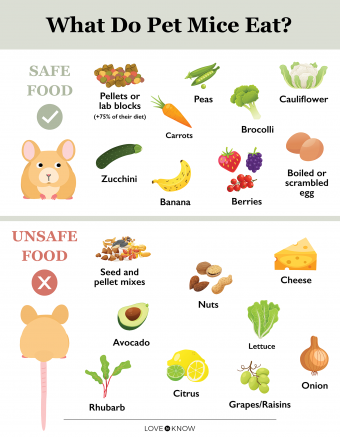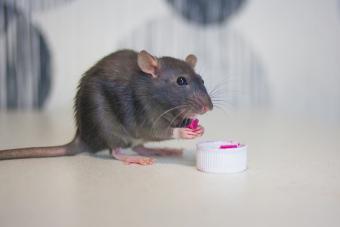
Mice are not herbivores like many other rodents; they are opportunistic omnivores, meaning they'll eat whatever is available to them, including vegetation and animal proteins. However, it's not healthy to feed your mouse anything and everything. Pet mice should eat a balanced diet of commercial mouse pellets supplemented with fresh vegetables and fruits. Discover how to feed your pet mouse a nutritious diet and which foods to avoid.
What Do Pet Mice Eat?
Pet mice must eat a diet consisting of species-specific pellets, fresh vegetables, and occasional treats.

Pellets or Block Diet
The majority of your pet's diet (approximately 75 to 80 percent) should be made up of commercially available mouse pelleted food. These are sometimes referred to as lab blocks or simply "block" diets because they come in larger block form and were originally designed for feeding laboratory mice. Block or pellet diets provide pet mice with balanced nutrition, including necessary carbohydrates, protein, fiber, fats, minerals, and vitamins.

Blocks may look too large for your small mouse to consume, but the gnawing action these blocks require is very important for their health. Chewing keeps a rodent's continuously growing teeth from becoming overgrown. Find a high-quality block or pellet diet formulated specifically for mice. The diet should contain at least 16 percent protein and 4 to 5 percent fat.
Vegetables
Fresh vegetables provide your mouse with additional vitamins and minerals as well as fiber. They should make up approximately 15 to 20 percent of your mouse's daily diet. Try to vary the type of vegetables you offer your mouse to prevent any gaps in nutrients and opt for high-fiber veggies.
Safe vegetable choices include carrots, peas, broccoli, cauliflower, cucumber, zucchini, and bok choy. Even though vegetables are beneficial for your mouse, they should still be given in moderation. Too much moisture from veggies can lead to diarrhea. Always wash any fresh produce before feeding it to your pet and remove any uneaten food from the cage after four to six hours.
Treats
Fruits, seeds, and other tasty treats should make up no more than 10 percent of your mouse's calorie requirements. Treats aren't essential, but the may serve as rewards during training, puzzles, or other enrichment, and can strengthen the bond you have with your mouse. However, too many high-calorie treats can lead to weight gain and obesity-related health conditions. Safe treats for mice include banana, apple, melon, berries, boiled egg, cereal, pasta, or commercial mouse treats.

Avoid Mouse Seed and Pellet Mixes
Many pet mice become ill because they don't receive a proper diet. The seed and pellet mixes sold in most pet stores may technically provide complete nutrition, but that's only if a mouse eats every type of food contained in the mix.
Mice tend to go for the tasty seeds first, and ignore the healthier pellets included in the mix. As a result, they do not receive a balanced diet and can become overweight due to the high-fat seeds. Mice are foragers and hoarders, so even if you see all the food disappear, you may later find a hidden supply of pellets they've stashed out of sight. The best way to avoid this is feeding a complete pelleted or block diet supplemented by fresh foods.
How Much to Feed a Pet Mouse
The amount to feed your mouse each day will depend on their size and the nutrient density of the diet you choose. In general, smaller mice can eat about 4 to 5 grams of food per day, whereas larger mice species may eat up to 8 grams. Always follow the feeding directions provided by the pellet manufacturer and consult with your veterinarian if you have any concerns. When feeding more than one pet mouse, you can multiply by the number of mice to get the correct feeding amount. Additional treats can be fed daily or every few days in very small amounts.
Scatter Feeding
Ideally, you should scatter the food around the cage to promote their natural foraging behaviors. This can be a method of enrichment and reduce the chance of one mouse guarding food in a single area, such as a feeding bowl, from the other mice. You can also split their total feeding volume into two smaller meals each day.
Foods to Avoid
It's almost as important to know which foods aren't good for mice. The following food items are unhealthy and could make your pet mouse sick.

- Nuts - high fat and salt content
- Citrus fruits - too acidic
- Cheese - high fat content and difficult to digest
- Lettuce - high water content can cause diarrhea
- Candy - high sugar content
Toxic Foods
Some foods are not just unhealthy for mice, but they can have life-threatening effects. These foods are toxic to mice.
- Fruit seeds
- Walnuts
- Grapes
- Raisins
- Avocado
- Rhubarb
- Onions
- Garlic
- Chocolate
- Alcohol
- Coffee
- Tea
What to Feed a Pet Mouse
You want your little friend to live as long as possible, and feeding them a truly healthy, well-balanced diet can help make that happen. Just don't forget that hygiene is also extremely important. Always have fresh water available, clean your pet's dishes every day, and keep their cage clean. With a balanced diet, your pet mouse will reward you with years of companionship.







